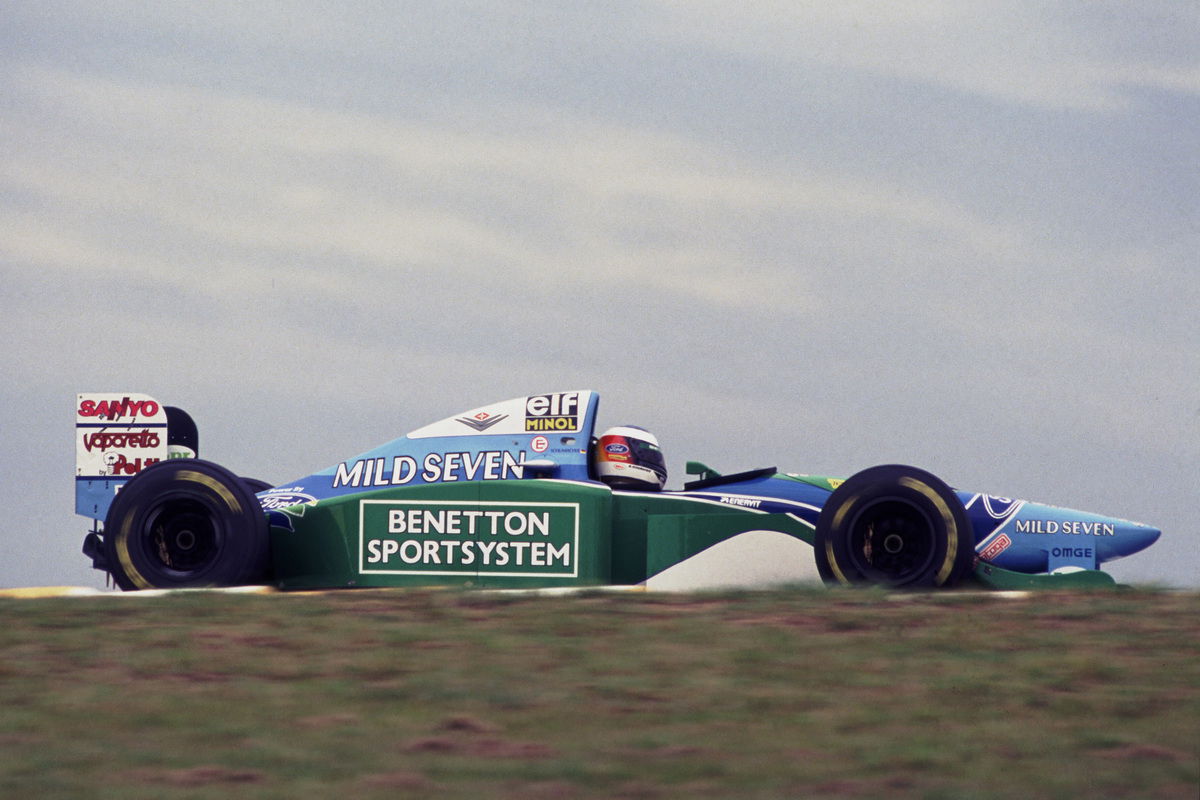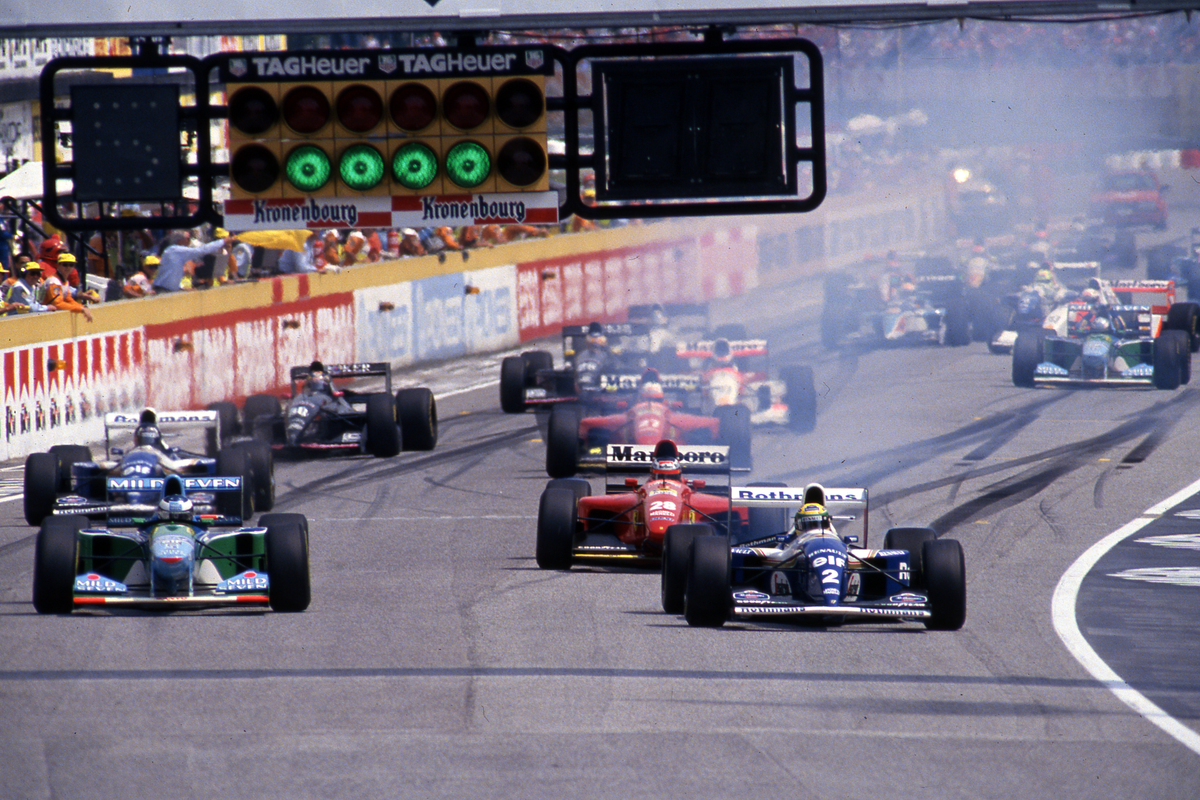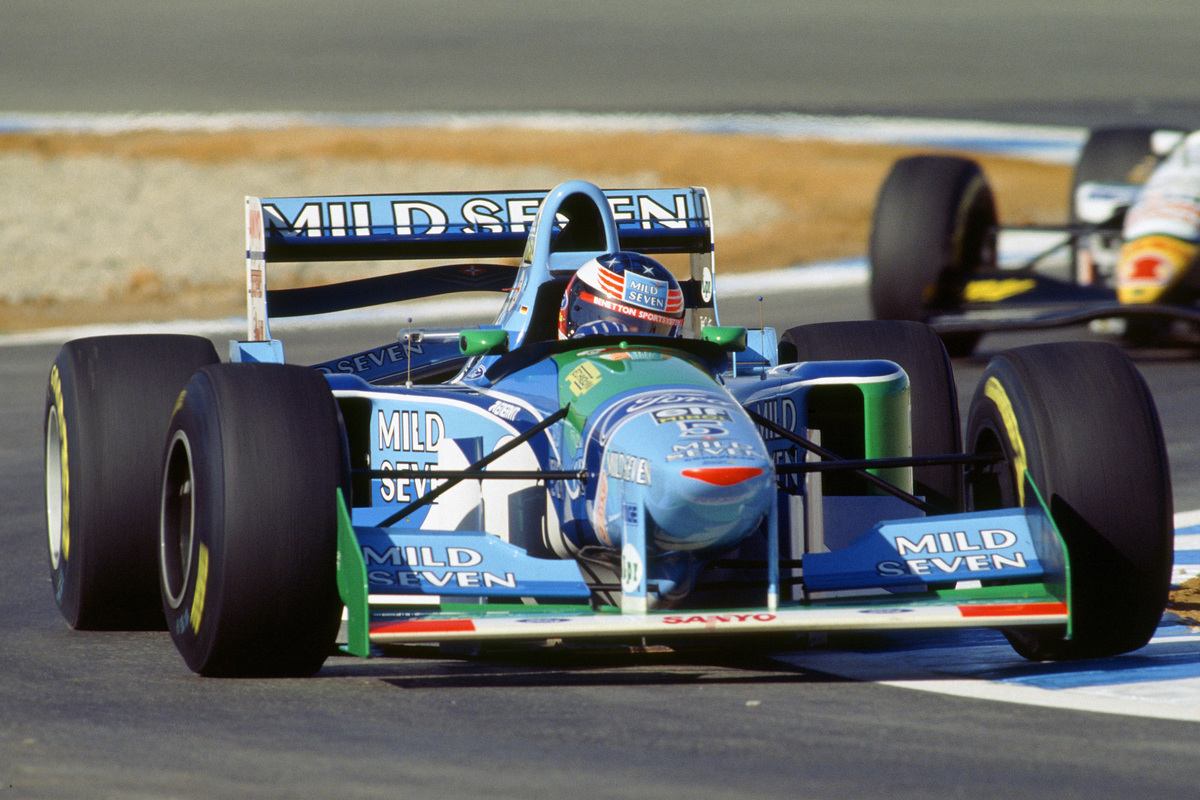

Michael Schumacher claimed his first F1 title in 1994 in one of the most dramatic, controversial, and sombre seasons in the sport’s history.
Schumacher overcame Damon Hill by a single point at the end of a tumultuous season that saw the deaths of Roland Ratzenberger and Ayrton Senna.
The controversial conclusion was the final chapter of a moment that had witnessed discontent within the paddock flare-up on multiple occasions.
At the heart of most of these was Schumacher’s Benetton team, which had established itself as a front-runner in the seasons prior but was in a position to challenge for the world championship for the first time in 1994.
Its main rival was the established best-in-class, Williams, which had won the previous two world titles with Nigel Mansell and Alain Prost respectively. With Senna’s arrival in 1994, it was expected that success would continue.
However, without active suspension, anti-lock brakes, and traction control, which were all banned following the 1993 season, the Adrian Newey-designed FW16 proved a handful.
Meanwhile, the Benetton B194 proved a strong contender, though questions surrounding its legality were soon raised.

“In early 1994 the great Ayrton Senna had to park his Williams car after some problem and chose to stay out on track for a while and watch/listen to the other cars,” wrote Willem Toet in a post on LinkedIn.
“He noticed the Benetton appear to stutter coming out of the slower corners which he thought must be traction control (it was). But the way Benetton had achieved it was quite legal.
“So the controversy starts.”
Toet, an Australian-educated engineer, had joined Benetton in the mid-1980s when the team was still known as Toleman and remained there until the end of 1994 when he joined Ferrari as its head of aerodynamics.
He had a front-row seat into the system Benetton employed to sidestep the ‘traction control’ ban.
The key was sensors that measured air pressure in the car’s airbox and the engine speed (rpm) and use that information (combined with known atmospheric measurements) to retard the car’s acceleration.
“Engines were permitted to sense atmospheric pressure and hence you had all you needed to modify the limit rate of acceleration of the engine in any gear,” Toet detailed.
“The atmospheric pressure sensor had to measure the pressure inside the airbox, because that is the air the engine is swallowing.
“The airbox is carefully designed by people like me to take full advantage of the forward velocity of the car to ram as much air in there as possible. This means we were increasing the air density.
“We weren’t allowed any sort of sensor that would tell the engine control unit (ECU) what gear the car was in.
“However, with some track testing, one could use the way pressure changed with speed in the airbox to determine that, if the pressure was ‘X’ above the ambient level seen at the start of the race, then the car was likely to be in a certain gear.
“To refine that process you just needed to know the RPM (another purely engine parameter). Hey presto traction control.”
Along with Senna’s suspicions was the allegation of a hidden menu in the Benetton’s electronics that resulted in an investigation following its discovery.
The resulting investigation established a banned launch control system, but could not ascertain whether it had ever been used.
An engineer’s job is to find exploits within the written regulations – whatever such exploit is termed (i.e. traction control) is irrelevant, provided it fits around technical regulations.
And that is what happened in 1994. Benetton found a legal exploit that in effect offered a rudimentary form of traction control within the rules.

“It was achieved via spark cutting (and the engine supplier was not too happy about it from an engine reliability perspective),” he revealed of the system.
“Input signals were engine RPM measured very frequently so that engine acceleration could be measured (hall effect sensors I believe) and atmospheric pressure (very accurate sensor) so that delta pressure could be assessed.
“Engine acceleration was limited in stages based on delta (‘atmospheric’) pressure.
“The driver would be sent out with the system ‘neutralised’ to see what the track/tyres could handle. This would change if gear ratios changed (different gear ratio would require a different engine acceleration limit).
“The system would then be programmed with a number of stages of engine acceleration to suit the conditions.
“As conditions changed (track ‘rubbering in’ etc.) the parameters would be tuned.
“During a race the conditions would change rendering the system more or less useful.
“If the tyres went off badly or it became wet the system would not control traction.
“If the track got better and better, the system would cut too much power – the grip available would allow more “engine” acceleration.”
Toet also provided technical insight alongside the theoretical aspects of the system.
“Spark cutting would start at one spark cut every, I believe, 15 sparks,” he explained.
“If f you know rpm then you know how often sparks would happen.
“Basically the team inserted a disruption to the power supply feeding the coils.
“Then you just cut low voltage power to the coils that create the high voltage for sparks for a few milliseconds (that is enough to disrupt the ability of the coils to spark) and cut again 15 sparks later.
“If rate of engine acceleration wasn’t under control (we’d know by how what percentage we were over the limit) the spark would be cut more frequently to one in seven sparks, one in six, five, four, three….
“With an eight-cylinder engine we did not want to cut sparks to the same piston too frequently – there is a risk of fouling the plugs and creating a real misfire.”
While Senna was not wrong in his suspicions, Schumacher and Benetton worked to conceal the system.
That included limiting its use or relying on it in a less evident manner.
“A good driver would use the system to learn how to apply the throttle,” Toet detailed.
“Driving flat out everywhere would be fine except that it wasted fuel and made a more detectable sound.
“While the team were satisfied the system was legal, it wanted to minimise visibility because they knew that would lead to ‘clarifications’ or regulation changes.
“They also didn’t want other teams working out what they were doing! Of course other teams did eventually work it out (staff transfer being one way).”

And so, Benetton raced in 1994 with a perfectly legal form of traction control despite the system being banned at the end of the previous season.
It was not the only controversy that year, with Schumacher banned for two races after his team appealed his exclusion from the Belgian Grand Prix.
There was also an incident at the British Grand Prix, for which the team was fined $25,000 after Schumacher did not serve a penalty within the prescribed period under the technical regulations.
Added to that was the fire at the German Grand Prix, after a filter had been removed from the filler which saw fuel leak onto Jos Verstappen’s car before bursting into flames.
Finally, the season concluded with contact in Adelaide, when Schumacher left the road before closing the door on Hill as he attempted to pass as they turned right onto East Terrace, eliminating both cars from the race and handing Schumacher the title.





















Discussion about this post